The story of how I came to own one of only three Odyssey2 trackball controllers known to exist is about as unlikely as you can get, because I didn’t set foot near one of the major retrogaming shows held around the country every year – or, at least, the show in question wasn’t major yet. An attendee at the 2003 OKGE show noticed my Odyssey2-centric collection on display and mentioned he had a trackball for that system, and asked if I wanted to see it. At the time (September 2003), only one other specimen was known to exist, so I admitted that 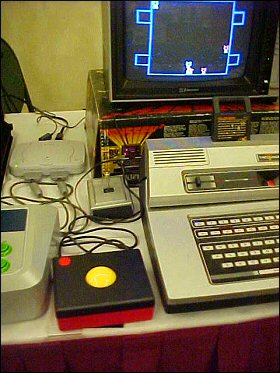 yeah, I definitely did want to see this. I half expected it to be a 2600 trackball.
yeah, I definitely did want to see this. I half expected it to be a 2600 trackball.
But lo and behold, it was the real deal – a second Odyssey2 trackball by Wico, in the box no less. (A third has since surfaced at CGE in 2004.) The trackball’s owner, James LeBlanc, then proceeded to leave it with me for a bit while he and his son roamed the floor. I immediately set about hooking it up to one of the Odyssey2 systems I had on display and gave it a spin, as it were. Sadly, I wasn’t able to get it to do much because I discovered it needed its own separate power adapter – the 9-pin ports of a detachable-controller Odyssey2 just don’t put enough juice through the line for anything but a digital joystick. And the AC adapter for this trackball was AWOL. It did, at least, send my UFO straight to the bottom of the screen in UFO! – so it was doing something. I took a few pictures for posterity, boxed the controller back up, and when James dropped by to retrieve it, I gave him my web site’s business card and told him I’d be more than happy to take the trackball off his hands.
The only problem was that I had already let on that this gadget was officially in the “priceless” category – one or two of a kind. Rarity 10. ER (extremely rare). Whatever you want to call it. I figured I probably hadn’t done myself any favors.
 A few weeks after OKGE, James got in touch with me again and gave me first dibs on the Odyssey2 trackball. I consulted with a couple of friends “in the know” about a reasonable price, and if there was a way you could hear a sharp intake of breath via e-mail, this is a time where you could imagine doing so. Nobody cared to put a numerical dollar value to the thing. While I was waffling on what to offer James, he surprised me with an asking price that was…well, let’s just say lower than anyone sanely expected.
A few weeks after OKGE, James got in touch with me again and gave me first dibs on the Odyssey2 trackball. I consulted with a couple of friends “in the know” about a reasonable price, and if there was a way you could hear a sharp intake of breath via e-mail, this is a time where you could imagine doing so. Nobody cared to put a numerical dollar value to the thing. While I was waffling on what to offer James, he surprised me with an asking price that was…well, let’s just say lower than anyone sanely expected.
Then came a gap of several months – James was having computer problems, and I was trying to buy a house with my wife, something which certainly pushed other financial considerations  aside, certainly anything related to video game collecting. In 2004, having bought a new house and moved in, I tried to get back in touch with James to see if he was still interested in doing the deal – and I held my breath and waited for word that it had been sold to someone else.
aside, certainly anything related to video game collecting. In 2004, having bought a new house and moved in, I tried to get back in touch with James to see if he was still interested in doing the deal – and I held my breath and waited for word that it had been sold to someone else.
To my surprise, James still had the trackball (“I figured you had probably found another one,” he said in an e-mail – I hope he can forgive me for laughing long and hard at that point.) I made arrangements to pay for the trackball, and it arrived not long afterward in my mailbox. Now I just needed to figure how out how to power it up with blowing it up or otherwise ruining it. After all, I only had one shot at this.
 To determine the trackball’s power requirements, I asked a friend of mine at work – a TV station engineer – to help me out, because I can barely tell the difference between volts and amps. I expected it to be a spare-time project, but a fortuitously slow work night meant that he was able to do the testing with the station’s equipment – hardly what it was intended for, and better than I’d hoped for. To my amazement (and more than a little bit of trepidation), he and one of the other engineers on staff basically field stripped the trackball. As in, one of the only three specimens known to exist was taken apart and put back together. (As scary as this was to watch, it had a nice side-effect – they were able to clean everything inside and basically restore it to right-out-of-the-factory condition.) They determined that the trackball ran on an unusual 5 volts of power, not a rating for which there are many off-the-
To determine the trackball’s power requirements, I asked a friend of mine at work – a TV station engineer – to help me out, because I can barely tell the difference between volts and amps. I expected it to be a spare-time project, but a fortuitously slow work night meant that he was able to do the testing with the station’s equipment – hardly what it was intended for, and better than I’d hoped for. To my amazement (and more than a little bit of trepidation), he and one of the other engineers on staff basically field stripped the trackball. As in, one of the only three specimens known to exist was taken apart and put back together. (As scary as this was to watch, it had a nice side-effect – they were able to clean everything inside and basically restore it to right-out-of-the-factory condition.) They determined that the trackball ran on an unusual 5 volts of power, not a rating for which there are many off-the- shelf AC adapters. It also took a bit of time to figure out if the tip of the required adapter was “hot” or “ground.” I got a universal multi-voltage AC adapter from Radio Shack and proceeded to take the trackball home and plug it in.
shelf AC adapters. It also took a bit of time to figure out if the tip of the required adapter was “hot” or “ground.” I got a universal multi-voltage AC adapter from Radio Shack and proceeded to take the trackball home and plug it in.
Nothing. To say that my heart sunk here would be a major understatement. It didn’t matter if this was the only Odyssey trackball specimen if it didn’t work. After a while, I worked up the nerve to actually increase the voltage on the adapter. 5.5 volts did finally did the trick – I was in business. The first game I tested out was UFO!, which seemed to lend itself naturally to the kind of free-floating movement that the trackball promised. I wasn’t disappointed.
What follows is a game-by-game report of games that I’ve played so far with the trackball. As of this writing, I haven’t exhausted the entire Odyssey2 library, mainly due to time as much as anything else. And there are common-sense exclusions as well – with keyboard-only games like Math-A-Magic! / Echo! and Keyboard Creations!, the controller of choice obviously wouldn’t matter one way or the other.
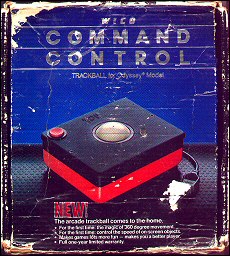 Cosmic Conflict! – Holy cow. Just when you’d thought this game had limited replay value, the trackball certainly puts a new twist on it. There’s a learning curve to it, but the controller makes this one rather interesting again – it lets you roll your targeting sights as smooth as that message from Star Command. The biggest hitch is trying to make the airplane-style control scheme of “up is down and down is up” instinctive.
Cosmic Conflict! – Holy cow. Just when you’d thought this game had limited replay value, the trackball certainly puts a new twist on it. There’s a learning curve to it, but the controller makes this one rather interesting again – it lets you roll your targeting sights as smooth as that message from Star Command. The biggest hitch is trying to make the airplane-style control scheme of “up is down and down is up” instinctive.
Freedom Fighters! – This is the first time I’ve liked this game in 20 years. The trackball offers very slick control – best used in a one-controller game played entirely in hyperspace, becasue you can drop “out of warp” on a dime, take care of some business, rescue some hostages, and get back on the road in short order. The only drawback being that it takes a lot of rolling for a sustained hyperspace trip, but avoiding obstacles during that trip is much easier.
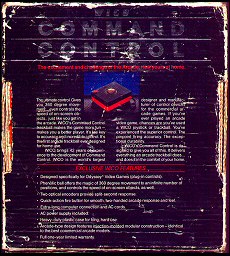 Killer Bees! – This game rocks and rolls with trackball control. Killer Bees! author Bob Harris himself said that this game was meant to evoke the same feel as Centipede, and with a real live trackball controller, the whole balance of the game shifts – sometimes in the player’s favor, sometimes not. It’s a very interesting game-play experience, probably the best Odyssey game to play with the trackball.
Killer Bees! – This game rocks and rolls with trackball control. Killer Bees! author Bob Harris himself said that this game was meant to evoke the same feel as Centipede, and with a real live trackball controller, the whole balance of the game shifts – sometimes in the player’s favor, sometimes not. It’s a very interesting game-play experience, probably the best Odyssey game to play with the trackball.
Power Lords – It’s tempting, in a slightly sadistic way, to pair the rarest Odyssey2 controller with one of the rarest Odyssey2 games, but after putting these two together at the 2004 OKGE show, I realized how ill-suited the game is to trackball control. It’s vital, in Power Lords, to be able to keep yourself pointed in one particular horizontal direction while having a great deal of flexibility in the vertical plane – and put simply, a trackball is not the way to achieve that. Not a recommended pairing, to say the least.
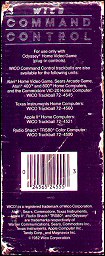 Turtles! – Oh, what the hell. It would’ve been crazy not to try this thing out on at least a few games that were absolutely unsuited for trackball control. Now, here’s the weird thing – it was actually kind of interesting. I was able to get into the thousand-point range with the trackball, though if you’ve played Turtles at all, you know that’s not anything to write home about. The biggest problem with the trackball is quick getaways, especially when you roll Mama Turtle into a question mark that turns out to be an extra bug to chase you around, or if there’s a bug hot on her tail. The trackball definitely adds an interesting “expert handicap” to Turtles.
Turtles! – Oh, what the hell. It would’ve been crazy not to try this thing out on at least a few games that were absolutely unsuited for trackball control. Now, here’s the weird thing – it was actually kind of interesting. I was able to get into the thousand-point range with the trackball, though if you’ve played Turtles at all, you know that’s not anything to write home about. The biggest problem with the trackball is quick getaways, especially when you roll Mama Turtle into a question mark that turns out to be an extra bug to chase you around, or if there’s a bug hot on her tail. The trackball definitely adds an interesting “expert handicap” to Turtles.
UFO! – It certainly makes the game more interesting, that’s for sure. With the trackball, UFO! becomes a ramming game, not a shooting game (honestly, I’ve always found that element of the game more interesting than keeping my guns blazing the whole time anyway). Depending on what kind of game you’re in the mood for, though, having to keep the ball rolling (so to speak) might make UFO! a bit tedious. And to put things in perspective, I managed to rack up a top score of 27 points in UFO! with the trackball, that being the top score out of about eight or ten games. Then I left the machine sitting to walk over to my PC to jot down these notes, and it scored 68 points just sitting there, not moving. I’d recommend this only for expert UFO! players.
There are several other games I plan to try out with the trackball, including Invaders From Hyperspace!, Kill The Attacking Aliens, War Of Nerves!, Showdown In 2100 A.D.!, Balao Travesso! and many others.
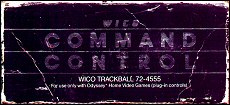 Why there are only three of these known to be out there is a complete mystery. It seems like there must be more of them – a prototype run doesn’t get foil-printed boxes with warranty cards. But perhaps the answer isn’t as mysterious as it would appear. A limited test-market run of Odyssey2 trackballs isn’t out of the question, but let’s look at another likely scenario – Wico also manufactured another trackball that required its own AC adapter, for the TI 99/4A computer. It’s possible that the Odyssey trackball was a limited run of specially modified TI trackballs to see if the market was there for Odyssey2 support – and it’s also possible that, in any case, with the crash of the video game industry in 1983, Wico recalled the existing Odyssey trackball controllers to retrofit and repackage them for the TI market, since the computer industry didn’t suffer quite the same catastrophic shakeout that the game industry did. The Odyssey2 trackballs may still be out there – but rewired for the TI.
Why there are only three of these known to be out there is a complete mystery. It seems like there must be more of them – a prototype run doesn’t get foil-printed boxes with warranty cards. But perhaps the answer isn’t as mysterious as it would appear. A limited test-market run of Odyssey2 trackballs isn’t out of the question, but let’s look at another likely scenario – Wico also manufactured another trackball that required its own AC adapter, for the TI 99/4A computer. It’s possible that the Odyssey trackball was a limited run of specially modified TI trackballs to see if the market was there for Odyssey2 support – and it’s also possible that, in any case, with the crash of the video game industry in 1983, Wico recalled the existing Odyssey trackball controllers to retrofit and repackage them for the TI market, since the computer industry didn’t suffer quite the same catastrophic shakeout that the game industry did. The Odyssey2 trackballs may still be out there – but rewired for the TI.
Aside from writing this article, I’m not keeping the trackball to myself. One of James LeBlanc’s requests when I bought it was that it wouldn’t be locked away in a trophy case somewhere – he hoped it would make the rounds of the retrogaming conventions so people could see it. For  this controller’s public debut, I tried to do even better than that, and actually had the trackball plugged in, powered up, and ready for anyone to play at OKGE 2004, and numerous people did indeed give it a spin, including James himself (without the adapter, he’d never seen it in action before). (For the record, I offered it as a display item to CGE and ECGX in 2004, since I know the organizers of both shows personally; I didn’t get a response in either case, which is probably more due to the barely-controlled chaos of trying to put one of those shows together than anything else.) I plan to continue showing off the Odyssey2 trackball at future OKGE shows, because this hobby isn’t about sitting back and admiring something like a sculpture. It’s about playing – rather hard to do when you can’t get your hands on the games and their accessories. So while I’m sure some collectors are sucking in their breath disapprovingly at the mere thought of letting everyone get their fingers all over such hard-to-find gear, I agree with James that the trackball should be seen – and played.
this controller’s public debut, I tried to do even better than that, and actually had the trackball plugged in, powered up, and ready for anyone to play at OKGE 2004, and numerous people did indeed give it a spin, including James himself (without the adapter, he’d never seen it in action before). (For the record, I offered it as a display item to CGE and ECGX in 2004, since I know the organizers of both shows personally; I didn’t get a response in either case, which is probably more due to the barely-controlled chaos of trying to put one of those shows together than anything else.) I plan to continue showing off the Odyssey2 trackball at future OKGE shows, because this hobby isn’t about sitting back and admiring something like a sculpture. It’s about playing – rather hard to do when you can’t get your hands on the games and their accessories. So while I’m sure some collectors are sucking in their breath disapprovingly at the mere thought of letting everyone get their fingers all over such hard-to-find gear, I agree with James that the trackball should be seen – and played.
A Big Ball Of Thanks To:
- James LeBlanc – for first dibs, a great deal, and a few months worth of patience
- Matt Stallsworth – for invaluable tech assistance to make sure I didn’t “fry the grail”
- William Cassidy – for an outstanding site (which features photos of one of the other one of these known to exist, by the way, as well as the all important electrical specs); visit his the Odyssey2 Homepage for more O2 goodness.
- Jesse Hardesty & family – for putting together the first OKGE, without which this would probably still be sitting in James’ garage